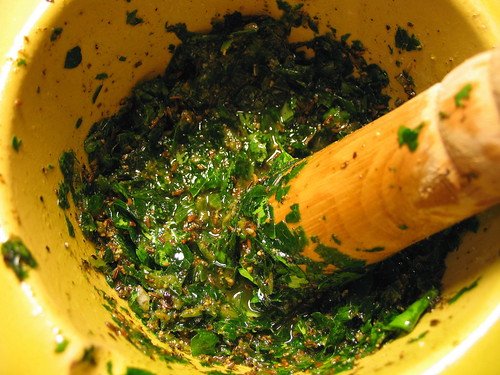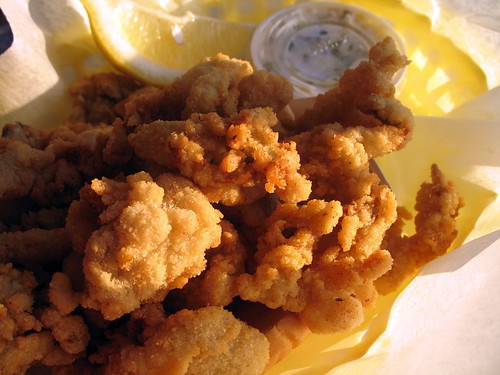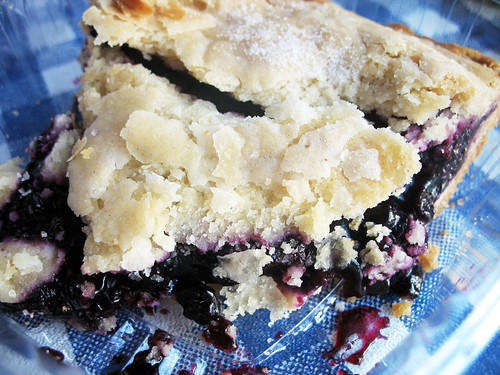It's all gone now, but during one recent week the Yemeni spice paste zhough wound up in just about everything in the Tiny Banquet kitchen. Early one morning I crushed a pile of chile peppers, spices and herbs to a pulp with a mortar and pestle—not an effortless task, but fortunately I had plenty of coffee before I got started—and voila, the result was a generous quantity of spicy, delicious, vivid green zhough.

The recipe below comes from Deborah Madison's
Local Flavors: Cooking and Eating from America's Farmers' Markets. Too often I buy a new cookbook and excitedly flag the most appealing recipes with post-it notes, only to put the book away without trying any of them. That's exactly what I did with
Local Flavors, unfortunately. Sometimes it happens because I've only just discovered a book during the wrong season (like when I stumbled across Claudia Roden's
Everything Tastes Better Outdoors one miserable February), but there are interesting recipes for every season in this book. I wish I could say I prepared an entire meal from it, but so far I've only gotten to the zhough.
I was intrigued by Madison's suggested uses for it: "A chile paste from Yemen with a hint of sweet spice,
zhough can be spread on pita bread or stirred into vegetable stews, soups, and sauces. Try it with grilled sweet potatoes or whenever you want extra heat and spice."
Madison explains that "[y]ou can use jalapeños, serranos, Anaheims, poblanos, or perhaps another chile that grows in your area. I usually use jalapeños with 1 serrano thrown in for extra heat and flavor." I only had serrano peppers, which can be quite a bit hotter than jalapeños, so I used only half the amount of them. 2 ounces of serrano peppers, if you were wondering, looks like this:

I was pleased with the level of heat; the paste was spicy, but not painfully so.
Green Chile Paste (Zhough)4 ounces fresh green or red chiles [see comments above]
1 teaspoon black peppercorns
1 teaspoon cumin seeds
1 teaspoon caraway seeds
1/2 teaspoon ground cardamom
1/2 cup coarsely chopped parsley
1/2 cup coarsely chopped cilantro
4 garlic cloves, peeled and chopped
olive oil to moisten
pinch sea salt
1. Remove the seeds and veins from the chiles, chop by hand or in a food processor and set aside. (If using food processor, stand back—the volatile oils can be irritating.)
2. Crush the peppercorns and spices in a mortar. Add the chopped chile, parsley, cilantro, and garlic and continue to work to make a smooth paste. Add oil to moisten—the zhough should have a paste-like consistency—and a pinch of salt. Keep refrigerated and use within a few days.I was initially afraid I wouldn't be able to use all my zhough but I ended up using every last spoonful. The first dish I made with it was possibly my favorite: I rubbed about two tablespoons of it underneath the skin of a chicken breast, and roasted it as usual.

It smelled fantastic, and the spice paste kept the meat juicy. I particularly enjoyed the flavor of the caraway and I regretted than I hadn't made an entire chicken this way.

If you want to try this, use your fingers to gently separate the skin from the meat, and evenly distribute about a tablespoon of the zhough underneath the skin on each side of the breast (or a bit less if your chicken is in smaller pieces; I'm sure this would be good with chicken thighs or legs as well). Rub the outside of the skin with a bit of olive oil or softened butter, season it with salt and freshly ground pepper, and roast as usual.

On the side we had braised carrots with galangal, which was inspired by Marcella Hazan's simple (but precise) method of cooking carrots, which you can read about
here. It sounds like it requires you to pay an inordinate amount of attention to your carrots, but it's not labor-intensive and the results are worth it. To make them with galangal (or fresh ginger) rather than Parmesan, simply add a tablespoon of grated or minced galangal (or ginger) to the pan along with the salt and the sugar, and omit the cheese.
I also want to mention something we ate before the chicken, because it was so good and I know I won't manage to fit it into another post: remember the
za'atar I wrote about a couple weeks ago, in my scallop post? It is amazing in deviled eggs, and fun to eat. When was the last time you ate deviled eggs?

Possibly years ago, right? I am definitely going to make these more often because the za'atar was so good with them, and it's not even necessary to make it in advance: simply stir a little fresh thyme and toasted sesame seeds into the egg yolk mixture (you only need a tiny bit of mayonnaise, more for texture than for flavor), and sprinkle a pinch of sumac on top after you've spooned the yolk mixture back into the egg whites. If you have any interest in assembling a vaguely-Middle-Eastern picnic, this is the perfect food to start with.
Returning to the zhough, my second-favorite use for it was stirred into chickpeas. Canned chickpeas are ok for this; just rinse them well under plenty of cold running water, drain them well, and pat them dry. Heat a tablespoon of olive oil in a sturdy pan over medium-high heat, add the chickpeas and cook until they are heated through and beginning to brown, and stir in a rounded tablespoon of zhough, or a little more or a little less, to taste. That's it. Chopped fresh parsley or cilantro is nice, but not necessary. If you have some good plain yogurt, a spoonful would be nice on top. These chickpeas as good at room temperature as they are warm, something to keep in mind if you
are considering a vaguely-Middle-Eastern picnic.

I used the rest of the zhough to marinate some shrimp, which I broiled and served on top of a simple green salad dressed only with olive oil and lemon juice.


They were good but not as good as the chicken, and I think the reason was their brief time under the broiler. Shrimp of this size need to cook only for about 3 minutes, but the heat mellowed the zhough's spiciness more than I expected. If I make these again I'll set some of the zhough aside and use it to make a dressing for the cooked shrimp.

































































